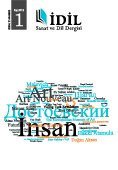TÜRK TAKILARINDA UMAY İNANCININ İZLERİ VE AVRASYA KÖKLERİ
FOLLOWING THE TRACES OF GODDESS UMAY IN TURKIC JEWELLERY
Author(s): Lale AvşarSubject(s): Cultural history
Published by: Sanat ve Dil Araştırmaları Enstitüsü
Keywords: Mother Goddess of Scythians; Umay; Turkic People Jewellery.
Summary/Abstract: It is understood that Goddess Umay, whose name is mentioned in Orhun Epigraphs, is thought to be equal to the Sky God and Ground-Water God, to establish the relations between the sky and ground, to provide all living beings with happiness, to carry souls into the sky after death, to render the eternal life and transformation possible and to be the protector of all living beings on the earth. This goddess leaving deep traces in Turkish culture and art has been preserved as a female spirit, and it has been known as the protector of women and babies. Though the iconography of Goddess Umay in Turkish art was determined during the Gokturk era, the roots of this iconography can be traced back to Eurasian geography and Goddess culture of antiquity. Therefore, especially the cultures in the first millennium BC, known as the Scythian era, provide us with plentiful materials; the descriptions of Tabiti, the ultimate Mother Goddess of Scythians, are viewed as the pioneer of Umay iconography. The traces of Umay belief in current Turkish cultures, in connection with its meaning that has been limited over time, are commonly seen on the goods and objects used by women. Preserving and protecting ability of Umay can be seen particularly in jewellery. In this study, Mother Goddess descriptions that we encounter in the cultures of Scythian era of Eurasia and the descriptions and symbols of Umay in women's jewellery that belong to current Turkic peoples were researched, and the common and similar aspects of these descriptions were pointed out. Moreover, the researcher attempted to prove that many motifs and details, the meanings of which have been forgotten, can be traced back to Umay.
Journal: İdil Sanat ve Dil Dergisi
- Issue Year: 1/2012
- Issue No: 01
- Page Range: 1-24
- Page Count: 24
- Language: Turkish

